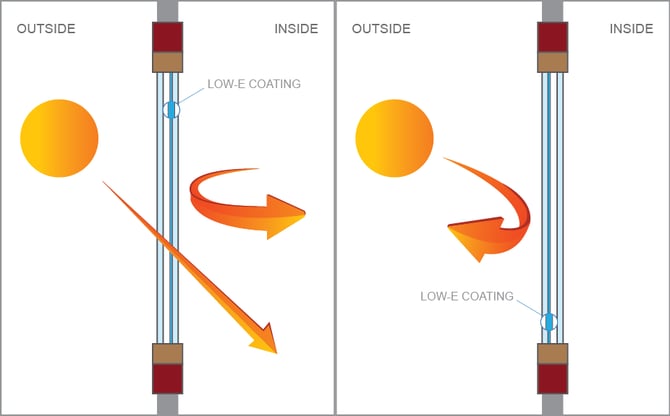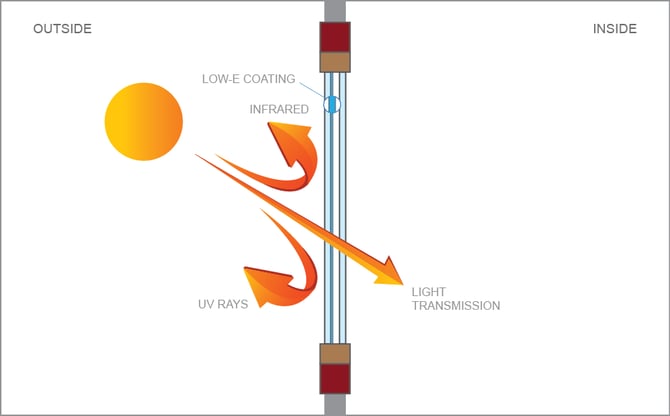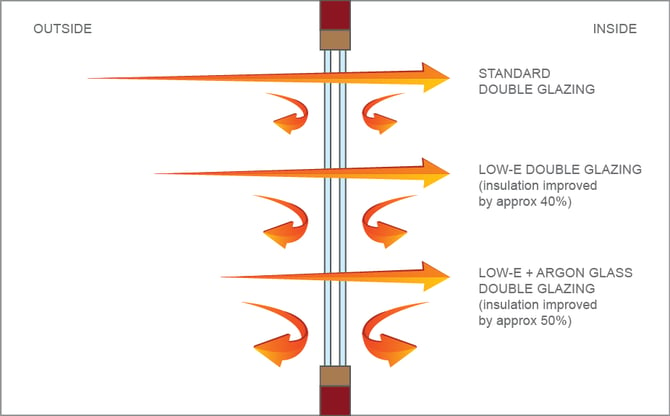If you’ve spent any time investigating how to make your windows more energy efficient, you’ve probably heard of low E glass. Low E, which is often used in double glazed windows because of its superior insulating performance, is one of the most popular – and most misunderstood, types of glass.
It has a lot to offer homeowners, particularly in the energy savings and home comfort departments. However, because the science behind low E isn’t intuitive, there are plenty of misconceptions surrounding how it works and what it is capable of.
Let’s unravel the mystery of low E glass once and for all.
Here’s a complete guide to:
- What it is;
- What the advantages are;
- How it’s made;
- How it impacts your window's visibility; and
- The cost of low E glass.
What Does the E in Low E Glass Mean?
Low E stands for ‘low emissivity,’ and emissivity refers to the thermal energy that naturally emits from glass. So, glass with low E properties is going to release less heat energy.
All objects, to some extent, will emit thermal energy in the form of radiant heat. Glass is a natural insulator, like woods and plastics, which means it is a good absorber of heat. It absorbs thermal energy from the sun or from your home’s interior heating, which then gradually releases from the glass into the space around it.
Then, this heat energy becomes either unwanted solar heat gain in the summer or unwanted thermal loss in the winter. The idea behind low emissivity is to stop a lot of the ‘unwanted’ emission of heat energy, whether the problem is the heat coming in during the summer or going out during the winter.

What Are the Benefits of Low E Glass?
The primary benefit of low E glass is to improve the insulating performance of your windows. With better insulation, you achieve a more comfortable home without having to turn up your heating or cooling systems. Whether you are battling high energy bills or simply want a more comfortable home and a lower household carbon footprint, low E glass can make a significant difference, especially in the long-term.
There’s another benefit of low E glass. Whilst it blocks a lot of the sun’s infrared rays – infrared energy is the sun’s heat energy – it also helps to block some of the sun’s UV rays.
Why is this important?
UV rays can damage your indoor furnishings over time. So, enjoying the sunlight flooding into your home means your expensive furniture and brilliantly coloured carpets will eventually fade.
Low E glass doesn’t block 100% of infrared or UV energy. Depending on the type of low E coating your glass has, with double glazed windows, you can block up to 70% of solar heat gain, dramatically lowering the solar heat gain coefficient (SHGC). It will also block the majority of UV light.

And the best part?
Low E glass still allows most of the visible light spectrum to flow through. This means you’ll enjoy the beauty and clarity of a sunny interior, without the drawbacks of thermal emissions and fading from UV exposure.
How Does Low E Glass Work?
Important question! How does a low emissivity coating stop glass from giving off as much heat?
It does this by reflecting the infrared and UV spectrum, whilst still letting the visible light spectrum pass through. The coating that is manufactured onto low E glass serves as a reflective service, causing heat energy to bounce back from where it came from.
Are Low E Windows Energy Efficient in the Summer and Winter?
Yes they are, making low E glass an attractive option in both cooler and warmer climates. The same principal that causes unwanted solar heat energy to bounce off your glass and back outside, will help to keep your indoor heat in during the winter.
In the summer, low E glass stops the bulk of the sun’s heat from ever entering your home, even with your curtains wide open. This allows you to rely less on your air conditioning to cool your home. In the cooler months, your indoor heat will reflect back indoors, meaning you’ll lose less of your home’s warmth and your heating unit won’t have to work as hard to keep your home comfortable.
How Is Low Emissivity Glass Made?
Low E glass is made by applying a microscopically thin coating to one surface of the glass. This coating is made up of multiple layers of reflective materials, consisting of different metals, metal oxides and metal nitrites.
You can’t see the coating, even if it is made up of several layers. Today, most window professionals work with a special type of low E glass known as soft coat low E, which has a coating with a thickness of one-ten thousandth of a human hair. This type of coating is transparent so your low E windows won’t have any colour to them.
Soft coat glass is made by depositing the coating to the surface in a vacuum chamber after the glass has been manufactured. This process is known as sputtering, which is why soft coat low E is also sometimes called sputtered glass.
Another way to make low E glass is to bond the metal oxide layers to the glass when it is still in its semi-molten state. Essentially, the coating is baked on, creating a hard surface. This type of low E glass is known as hard coat low E, or pyrolytic glass, referring to the pyrolytic manufacturing process.
Hard Coat vs. Soft Coat Low E Glass
Which is better – hard coat or soft coat low E glass?
Ten years ago, hard coat low E glass was more commonly used because it was believed that the hard coat and low corrosion resistance of the pyrolytic low E surface was preferable to the soft coating of sputtered glass. Over the years, glass technology improved, however, enhancing the sputtering process to make soft coat glass a smarter option. In fact, Thermawood franchisees will only use soft coat low E glass where possible because it has much better low emissivity properties.
Here’s why.
The ‘soft’ coat is made from one or more layers of silver. Silver is far superior to other metals as a reflective material. It also offers better clarity. As a result, soft coat glass will reflect more heat energy and yield a fully transparent window. Silver isn’t as hard or resistant as other metals (thus the term soft coat for the silver layers in the coating), but today glass manufacturers layer the silver with other metal oxides, resulting in a surface that is both highly reflective and resistant.
Also, the low E coating in a double glazed window – which consists of two panes of glass separated by an air space – is always used on one of the two interior facing surfaces. This means, the low E surface always faces the air space, where is it protected from the elements and exposure to cleaning products and other chemicals.

Hard coat glass, on the other hand, doesn’t perform as well because the coating isn’t as reflective. It also creates a slightly murky tinge, which reduces the visibility of your windows. As even a hard coat would be placed on the surfaces that face the air gap in a double glazing unit, there’s no need to sacrifice clarity, aesthetics and performance in order to get a harder surface.
Is Low E Tinted Glass?
Because of the greenish-tinge that older low-e windows used to have when hard coat low E glass was being used, some people still think of low E glass as a type of tinted glass. Or, they may assume low E glass is tinted glass.
Low E glass and tinted glass are two completely different types of glass, with differing properties. Tinted glass windows don’t have great insulating benefits. What they can do is block some UV rays. They also have a very serious downside, which is why Thermawood professionals won’t recommend this type of glass.
What happens is the colour that is added to tinted glass can actually attract more heat energy. This can be problematic as the part of your window that isn’t tinted will be cooler, whilst the tinted glass will be warmer. This temperature conflict can stress your window glass, making it more vulnerable to breaking.
What does low E glass look like?
It doesn’t look like tinted glass, but rather like standard glass. With soft coat low E glass, which is what most window company’s use today for professional window upgrades, your window will look crystal clear. You won’t see a coating, colouring or shading, even when the sunlight hits the window.
Low E Glass vs. Double Glazing
To get the best insulation, should you use low E glass or double glazed windows? Low E glass is actually used when you upgrade your windows with a double glazing unit. You can use low E glass for one or both of the panes of glass in the double glazing unit, depending on the unique needs of your property.
It’s possible to use a low E film without using double glazed windows. You can apply a plastic film made with a low emissivity coating to reduce the amount of heat transfer of your windows. Low E plastic film will, however, not be able to offer significant results or perform anywhere near as effectively as double glazing because you’ll still only have a single pane window.
Even with a special film, a single glaze isn’t capable of stopping much unwanted heat gain, cold drafts, and even noise pollution from entering your home. Also, these films will change the appearance of your glass, creating a cloudy look.
How Much Does It Cost to Install Low E Glass?
The cost of upgrading to low E windows will vary depending on the specific characteristics of your double glazing glass (glass thickness, if you use argon gas in the air space, other glass features such as acoustic grade or special safety glass) and whether you have new windows installed or you convert your existing windows with retrofit double glazing.
In general, you’ll pay about a third of the price of having new double glazed windows installed with Thermawood's retrofit double glazing. When your windows are retrofitted, your existing timber frames remain – with Thermawood’s patented dry retrofit process, they are efficiently converted, sealed for drafts and re-fitted with a custom-tailored insulated glass units.
Not only is retrofitting considerably less expensive, it’s also less destructive to your building. The aesthetics and existing structure of your windows stay intact. This means even if you have a Heritage home or building, you can still upgrade to low E double glazed windows without worrying about ruining your beautiful windows.
With retrofitting, the cost of low E glass per square metre will increase the price of a window conversion by 8% to 12%. However, double glazed windows with low E glass will make your home approximately 40% more energy efficient than double glazed windows without low E glass.
If you want even greater insulating properties, you can also have argon gas, an inert gas, inserted into the air space. Argon plus low E glass will make your windows approximately 50% more energy efficient than standard double glazing.

With better windows, you'll take a huge chunk out of your energy bills – in both hot and cold weather. You’ll be able to keep your curtains and blinds open, letting in that brilliant sunshine all year round. And, the clarity and aesthetics won’t change.
When you understand just how worthwhile low E glass is, you can see why low emissivity glass is so common in professional window conversions.






